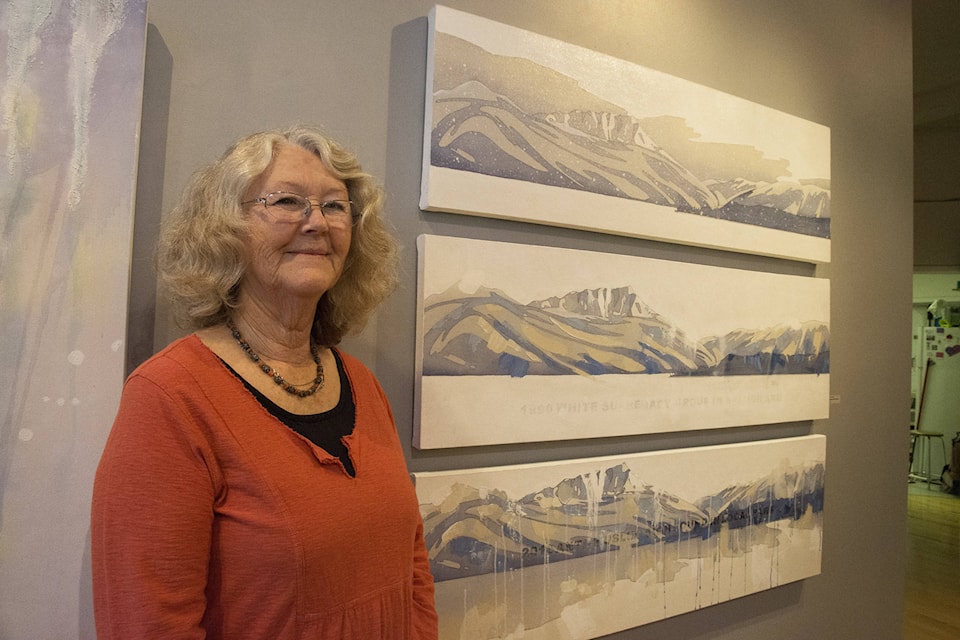Linda Franklin knows well that a beautiful facade can hide an ugly truth.
The longtime artist and architectural designer is putting her own twist on what is called the post-modern style of painting.
A triptych shown at “True North,” the recent juried artists’ exhibition at the Salmon Arm Art Gallery, portrays her underlying concerns about racism against a backdrop of beautiful Mt. Ida.
More than 50 years since she took formal lessons, Franklin enrolled in a third-year fine arts course at Thompson Rivers University last year.
There she was introduced to post-modernism, an approach she says arose in the 1970s and spread to many disciplines.
“Painting used to be about technique and beauty,” she says. “(Now) beauty doesn’t seem to be valued and can be considered suspect.”
She says students are being taught to encourage cultural comment and build culture.
Describing herself as a post, post modern artist, Franklin is making social comment but continues to believe in beauty. She says she uses it to draw viewers into her work.
In the first painting of her Great “White” North triptych, viewers see a serene winter scene of Mt. Ida, snow softly falling on the winter landscape.
The second painting is based on the same image but is leaning toward the abstract. The quiet quality of the snowfall is jarred by text beneath the scene: “1996 White Supremacy Group in Salmon Arm.”
There is further disintegration in the harsh lines of the third painting whose text relates to anti-Muslim signage displayed locally in 2016 after Syrian refugees had arrived.
Franklin says racism in Salmon Arm has been palpable in some quarters over the years.
“I am aware of resistance to the immigrants and people’s colour,” says the artist who is a member of the sponsoring group that welcomed the first Syrian refugee. “I have been told there used to be a policy at the local mill that employees should be white. That offended me.”
Rather than calling herself an activist, Franklin says she is making art about issues that concern her.
“Salmon Arm is my place – this is my inspiration,” she says. “Last year it was about immigrants; this year it’s about water.”
Born in Salmon Arm, Franklin was introduced to art by her grandfather when she was about seven or eight.
She laughingly describes how she was seduced by the smell of turpentine, something her grandmother loathed.
Franklin left Salmon Arm when she was six years old and lived with her family in India and Pakistan. She met her husband in England where she attended the Heatherlies School of Fine Art, the Chelsea School of Art and the London College of Furniture.
The couple moved to Vancouver and Franklin joined the design team of the prestigious firm of Ericson-Massey Architects in 1969.
In the early ’70s, Franklin turned to interior design and from 1972 to 1978, was a self-employed importer and retailer of raw wool, yarns and dyes.
The artist and her husband returned to Salmon Arm in 1978 and working with her contractor husband, began a 30-year career as an architectural designer, designing and drafting full working drawings for single family homes.
Putting her talents to good use, Franklin designed her own Salmon Arm home as well as one for each of her three children.
Franklin loves colour and favours acrylic paints, which she says provide her with instant gratification.
Her career in art began in earnest in 2007, when Salmon Arm Art Gallery Curator Tracey Kutschker invited her to put together a show.
With her late husband’s support, Franklin created 52 works of art.
Franklin walks and drives along back roads, taking photos of scenes that interest her.
“I use the forms and shapes then play with colour and texture,” she says, noting she paints as the mood strikes. “Sometimes I paint at night and other times I can’t wait until breakfast.”
About a decade ago, Franklin, Kutschker and Lisa Figueroa formed Lazuline to paint triptychs together.
Only one of the 15 triptychs the three created remains unsold.
“It’s hard to paint with other people, deciding on images and co-ordinating them,” she says. “Each one must stand on its own.”
To see Franklin’s work, go online to lindafranklin.ca.
